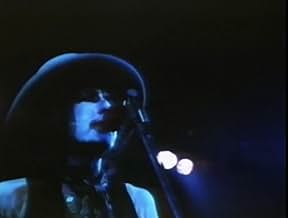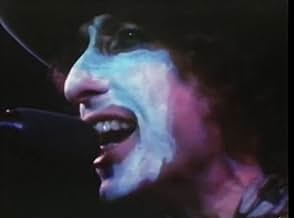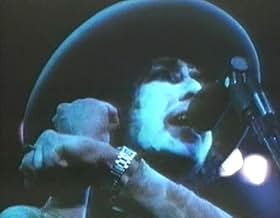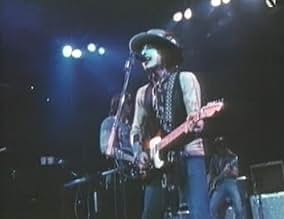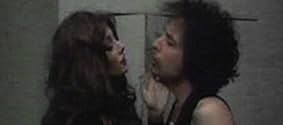VALUTAZIONE IMDb
6,6/10
639
LA TUA VALUTAZIONE
Bob Dylan nel suo tour del 1975 Rolling Thunder Revue: estratti dai concerti, interviste e bizzarre scene improvvisate.Bob Dylan nel suo tour del 1975 Rolling Thunder Revue: estratti dai concerti, interviste e bizzarre scene improvvisate.Bob Dylan nel suo tour del 1975 Rolling Thunder Revue: estratti dai concerti, interviste e bizzarre scene improvvisate.
- Premi
- 2 vittorie totali
Ramblin' Jack Elliott
- Longheno de Castro
- (as Jack Elliott)
Ruth Tyrangel
- The Girlfriend
- (as Ruth Tyrangiel)
J. Stephen Soles
- Ramon
- (as Steven Soles)
Recensioni in evidenza
These days most everything is inherently cinematic: poetry, music, literature.
That's a good thing if you understand how cinema works and can escape its control when needed. One technique is to retreat to non-cinematic art, to surf the various pathways therein and then come back to the moving image from the outside.
This film, if you can find the five hour version, can provide one such exercise. Dylan builds his songs around images, but they are not images from film or film-influenced phrases. His images are what appears in dreams, originating in real life and sliced and diced by drugs. (Incidentally, the period of this film marks the transition from active tripping of various kinds to passive by his "acceptance" of fundamentalism another drug.)
His method has always been to eschew a plan, to avoid premeditated structure, to abandon great themes. Instead, he just starts, waits for images and ideas to appear and then arranges them on the table. His art is a combination of selection and composition. The selection is a matter of discarding everything that seems to be simple. That automatically puts him in the world of the Tambourine Man, where he has been in various guises for decades.
The matter of composition is something else. He just trusts how they appear. Since they all come from one mind, and that mind is coherent and somewhat interesting, they hang together. He doesn't know how they do and has given up questioning, except for a brief period of examining Kabbalah.
That's how he does it with his music, and it works to judge from his audience. He also does it with his prose rambles. This works less well; the act of juxtaposing elements in his songs leverages the vocabulary of rhythmic associations he pretty much invented. But he has no equivalent to serve his writing projects, so most of them come across as sophomoric. Same with this film.
He just started. But images in film (at least films like this) have to come from things that are presented in the real world. He relies on some friends to help create and select the images/ scenes/sequences. Ginsberg is an anchor who does understand the rhythms of poetry where Bob does not, but he is as ignorant as Bob concerning film.
Another friend is Sam Shepard who is credited as co-writer. During this time, he was working with Terence Malick on another project which is about the same problem of selection. Shepard and Malick for that matter have a coherent theory of "selection" that they can use in conceiving their projects and setting the basic tone. We can see much of that here; it all relates to folding of persons into characters that are assignable to other bodies. Thus we have many "actors" playing more than one role; roles that are assigned to more than one actor; scenes that are copied from real life; lives that are generated from scenes (bordello vignettes, Indian cosmologies, Black injustices, beat poems...)
That's the selection half and it is interesting as all getout. The composition half is pure dreck. Dylan trusts his intuitions as he always does. But these pieces don't all come from the inner spinning of a whole mind like Kieslowski's or Tarkovsky's. They come from all over and he stitches them together as if they did actually come from his visions. But they didn't so it has no coherent being.
He tries to use songs, his and others, as glue. Some of these are enjoyable by themselves but they sure don't help assemble a cinematic being.
Ted's Evaluation -- 2 of 3: Has some interesting elements.
That's a good thing if you understand how cinema works and can escape its control when needed. One technique is to retreat to non-cinematic art, to surf the various pathways therein and then come back to the moving image from the outside.
This film, if you can find the five hour version, can provide one such exercise. Dylan builds his songs around images, but they are not images from film or film-influenced phrases. His images are what appears in dreams, originating in real life and sliced and diced by drugs. (Incidentally, the period of this film marks the transition from active tripping of various kinds to passive by his "acceptance" of fundamentalism another drug.)
His method has always been to eschew a plan, to avoid premeditated structure, to abandon great themes. Instead, he just starts, waits for images and ideas to appear and then arranges them on the table. His art is a combination of selection and composition. The selection is a matter of discarding everything that seems to be simple. That automatically puts him in the world of the Tambourine Man, where he has been in various guises for decades.
The matter of composition is something else. He just trusts how they appear. Since they all come from one mind, and that mind is coherent and somewhat interesting, they hang together. He doesn't know how they do and has given up questioning, except for a brief period of examining Kabbalah.
That's how he does it with his music, and it works to judge from his audience. He also does it with his prose rambles. This works less well; the act of juxtaposing elements in his songs leverages the vocabulary of rhythmic associations he pretty much invented. But he has no equivalent to serve his writing projects, so most of them come across as sophomoric. Same with this film.
He just started. But images in film (at least films like this) have to come from things that are presented in the real world. He relies on some friends to help create and select the images/ scenes/sequences. Ginsberg is an anchor who does understand the rhythms of poetry where Bob does not, but he is as ignorant as Bob concerning film.
Another friend is Sam Shepard who is credited as co-writer. During this time, he was working with Terence Malick on another project which is about the same problem of selection. Shepard and Malick for that matter have a coherent theory of "selection" that they can use in conceiving their projects and setting the basic tone. We can see much of that here; it all relates to folding of persons into characters that are assignable to other bodies. Thus we have many "actors" playing more than one role; roles that are assigned to more than one actor; scenes that are copied from real life; lives that are generated from scenes (bordello vignettes, Indian cosmologies, Black injustices, beat poems...)
That's the selection half and it is interesting as all getout. The composition half is pure dreck. Dylan trusts his intuitions as he always does. But these pieces don't all come from the inner spinning of a whole mind like Kieslowski's or Tarkovsky's. They come from all over and he stitches them together as if they did actually come from his visions. But they didn't so it has no coherent being.
He tries to use songs, his and others, as glue. Some of these are enjoyable by themselves but they sure don't help assemble a cinematic being.
Ted's Evaluation -- 2 of 3: Has some interesting elements.
Renaldo And Clara was hit hard by critics, but was a true testimont that Bob Dylan (Robert Zimmerman) is the true modern leader of entertainment, and learder of social change.
P.S. I would also like to find somewhere where I can buy this movie.
P.S. I would also like to find somewhere where I can buy this movie.
The movie was filled with bad acting.
Plus, this movie did Joan Baez extremely dirty, erasing the fact that Joan Baez dated Bob Dylan in 1964. In 1965 Bob Dylan cheated on Joan Baez with Sara Lownds, then he goes & re-write history in Renaldo and Clara, turning Joan into the 'other woman' in his fairy tale marriage.
Warning: At the timestamp of 3 hours 20 minutes, Bob Dylan starts gargling. What is this? A Cofsils experdine gargle commercial?
Alternate title of the movie: This Movie is a Giant Middle Finger to Joan Baez. Dump Joan Baez, break her heart, marry the other girl named Sara Lownds, and then flip the tables and cast Joan Baez as the other girl instead. Talk about erasing the truth, eh? Plus, gargle a while to make audience confused and make people fools for 4 hours straight and pretend it to be a cinematic masterpiece".
Plus, this movie did Joan Baez extremely dirty, erasing the fact that Joan Baez dated Bob Dylan in 1964. In 1965 Bob Dylan cheated on Joan Baez with Sara Lownds, then he goes & re-write history in Renaldo and Clara, turning Joan into the 'other woman' in his fairy tale marriage.
Warning: At the timestamp of 3 hours 20 minutes, Bob Dylan starts gargling. What is this? A Cofsils experdine gargle commercial?
Alternate title of the movie: This Movie is a Giant Middle Finger to Joan Baez. Dump Joan Baez, break her heart, marry the other girl named Sara Lownds, and then flip the tables and cast Joan Baez as the other girl instead. Talk about erasing the truth, eh? Plus, gargle a while to make audience confused and make people fools for 4 hours straight and pretend it to be a cinematic masterpiece".
At over four hours and consisting of a lot of improvised and apparently self-referential scenes, this could and indeed has irritated many viewers. But if one stays with it and takes it as it comes (Dylan himself has recommended that one watches it doped), the film is an extraordinary meditation on the nature of self, performance, show biz and life. At its heart, the film seems to me to be saying that everything is show business (love, politics, poetry) or perhaps that show business (represented by a cheesy club act) is as valid a life choice as any of the more profound things portrayed. For all his supposedly radical support for Rubin Carter, the film suggests that the boxer is just as much a performer as anyone else. The film contains some moving sequences, not least the wonderful one in which Alan Ginsberg performs Kaddish before a group of oldsters. And not least, the concert footage of Dylan is magnificent - Isis being a stand-out. Which brings me back to the movie's theme: here is a performer whose name is not really Bob Dylan playing a performer who is called Renaldo performing a song about marriage but not marriage to his wife Sara (who plays Clara in the film) but marriage to the ancient Egyptian Goddess Isis - which implies that the singer really is Osiris, God of the underworld. But it's just this kid Robert Zimmerman! What is the real truth? This is the sort of heady trip the film offers. Put up with the irritating self-indulgence of much of this,and the enormous length, and there are great rewards. Re-issue it, Bob!
Quirky, idiosyncratic, often confusing and much too long mixture of concert footage, documentary and fictional scenes is definitely fascinating to watch, but one wonders, if Bob Dylan ever was certain about his intentions to create this film or whether he had an idea who its potential audience would be.
Lo sapevi?
- QuizThe film got many negative reviews, and some theaters refused to show it. Most theaters showed a two-hour cut that was mostly concert footage. The original four-hour director's cut was first shown on European television years later.
- Citazioni
The Truck Driver: Why are you so much in a hurry? Is the law after you?
Renaldo: I am the law!
- Curiosità sui creditiThe opening credits end with a title card reading "A Film by BOB DYLAN" directed after he is credited as writer and director. The closing credits are divided in three sections, separated by wide time gaps, played over a different artist, soul singer Hal Frazier, performing "In The Morning", a song written by Barry Gibb.
- Versioni alternativeOriginally released at 292 minutes (yes, that's almost five hours!). After dismal box office returns, Dylan shortened the film to 122 minutes removing almost all of the narrative storyline and leaving mostly concert footage.
- ConnessioniFeatured in Bob Dylan: Change on the Tracks (2008)
- Colonne sonoreWhen I Paint My Masterpiece
Written and performed by Bob Dylan
I più visti
Accedi per valutare e creare un elenco di titoli salvati per ottenere consigli personalizzati
- How long is Renaldo and Clara?Powered by Alexa
Dettagli
- Tempo di esecuzione3 ore 55 minuti
- Mix di suoni
- Proporzioni
- 1.85 : 1
Contribuisci a questa pagina
Suggerisci una modifica o aggiungi i contenuti mancanti

